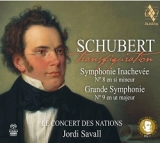In Sachen Schubert habe ich lange keine so aufregende Interpretation gehört wie die der 9. Symphonie unter der elektrisierenden Leitung von Jordi Savall. Da geht es hoch her, und das schwere Pathos, das dieses Werk so gefährlich macht, wird hier auf ein akzeptables Niveau reduziert, wenngleich Savall die Neunte recht klangprächtig und mit vielen Effekten angeht.
Natürlich spielt die historisch informierte Aufführungspraxis eine große Rolle, aber Savall ist immer um das musikantische Element und einen natürlichen Puls bemüht. Es gibt nur wenige Aufnahmen, die den historischen Klang mit dem großen Atem eines Wilhelm Furtwängler auf eine solch kongruente und passende Weise miteinander verbinden. Doch so spannend diese Neunte auch ist, Savall verschießt sein Pulver bereits im ersten Satz. Dieser wird so atemberaubend von Le Concert des Nations gespielt und so inspirierend von Savall dirigiert, dass sich dieser interpretatorische Ausnahmezustand in den Folgesätzen nicht mehr wiederholen kann. Insbesondere das abschließende Allegro Vivace büßt etwas an Kraft, Phantasie und Energie ein.
Auch die 8. Symphonie, die Unvollendete überrascht in jeder Hinsicht. Hier ist es vor allem der dramatische Atem Furtwänglers, den Savall heraufbeschwört und der dieser Symphonie im Klanggewand der historischen Aufführungspraxis erstaunlich gut zu Gesichte steht. Der großzügige und etwas hallige Klang der Kirche Saint-Vincent Collégiale de Cardona ist sicherlich nicht jedermanns Sache, aber für Savalls Interpretation passt er.
When it comes to Schubert, it’s been a long time since I’ve heard such an exciting interpretation as that of the 9th Symphony under the electrifying direction of Jordi Savall. It’s high-pitched, and the heavy pathos that makes this work so dangerous is reduced to an acceptable level here, even though Savall approaches the Ninth quite sonorously and with many effects.
Of course, historically informed performance practice plays a major role, but Savall cares for the musicianly element and a natural pulse. There are few recordings that combine the period sound with the big breath of a Wilhelm Furtwängler in such a congruent and fitting way. But as exciting as this Ninth is, Savall shoots his powder in the first movement. This is so breathtakingly played by Le Concert des Nations and so inspiringly conducted by Savall that this interpretive exceptionalism cannot be repeated in the subsequent movements. In particular, the concluding Allegro Vivace loses some of its power, imagination and energy.
The 8th Symphony, the Unfinished, also surprises in every respect. Here it is above all Furtwängler’s dramatic breath that Savall conjures up and that suits this symphony amazingly well in the sound garb of historical performance practice. The generous and somewhat reverberant sound of the Saint-Vincent Collégiale de Cardona church is certainly not to everyone’s taste, but it suits Savall’s interpretation.
























